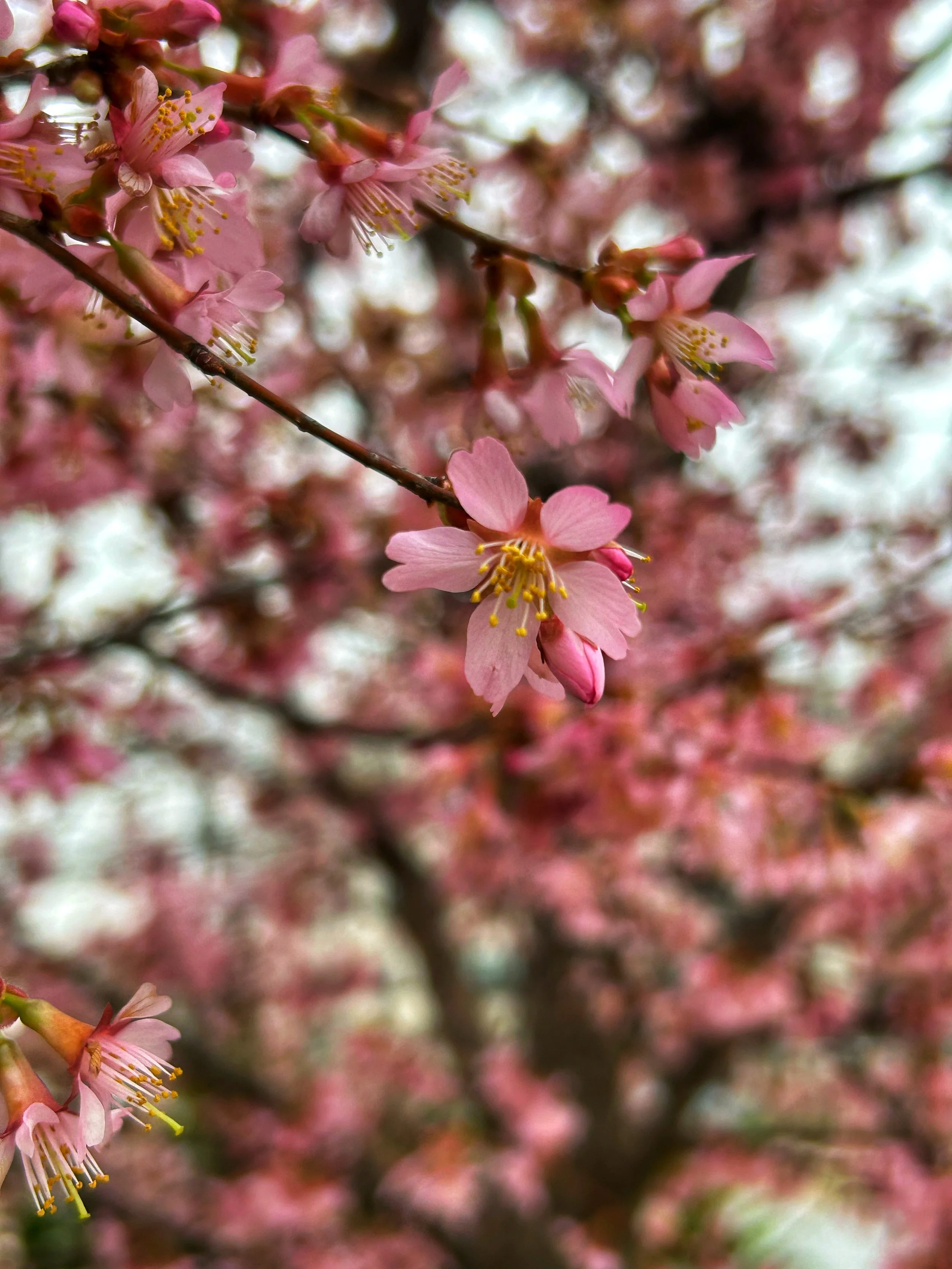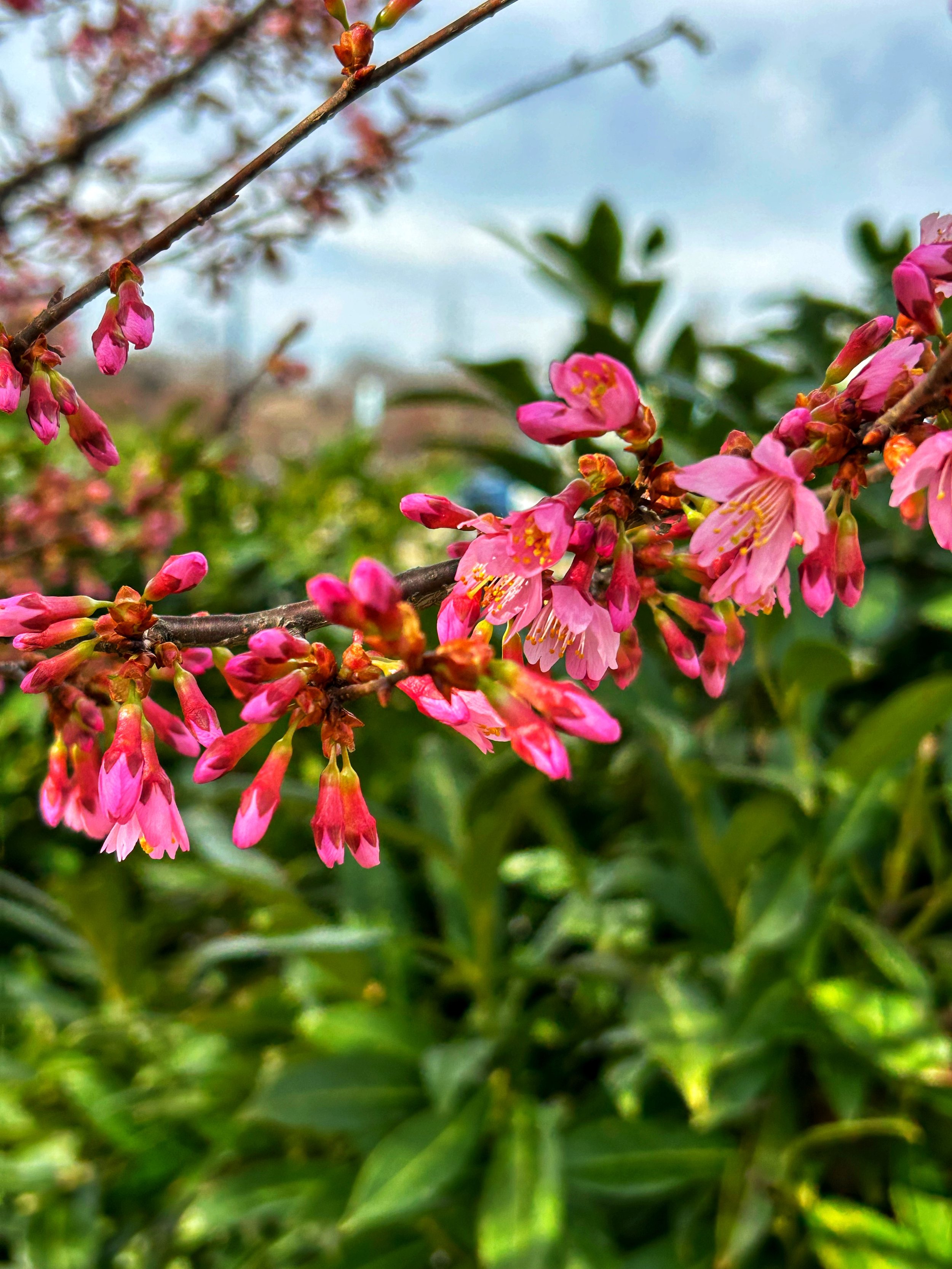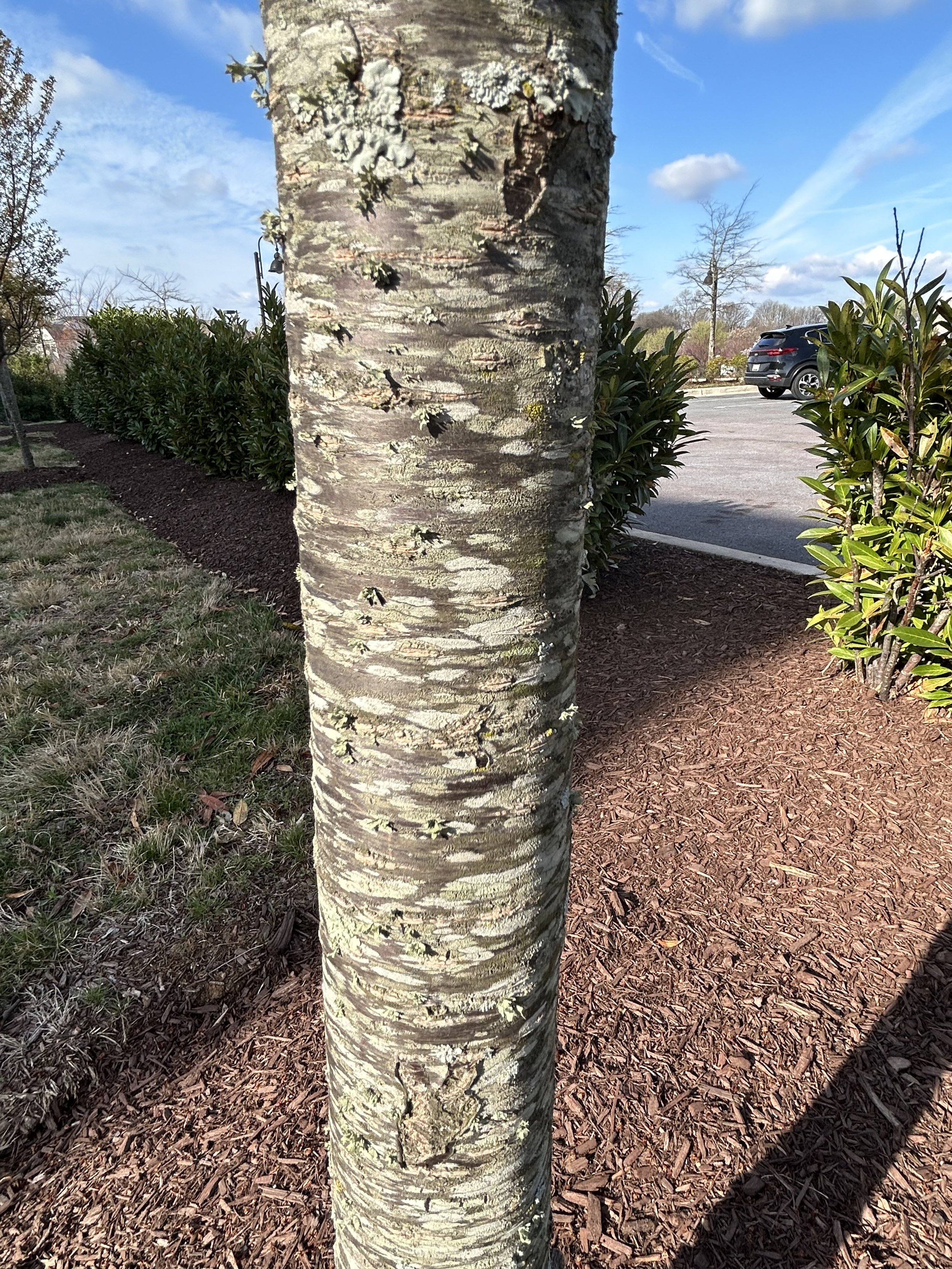Okame Cherry Tree
Easy to Grow!
A Resilient Hybrid that Triumphs over Heat, Humidity and Drought
The Okame cherry tree is a small, deciduous tree known for being heat tolerant, cold tolerant, and easy to grow in zones 5-9. A hybrid cross between Prunus incisa and Prunus campanulata, the Okame cherry is also referred to by the latin names Prunus x incam, Prunus x incamp, or simply Prunus ‘Okame’.
The Okame cherry is one of the earliest cherry trees to bloom, with fragrant hot pink flowers carpeting the branches for up to three weeks in late winter to early spring, attracting pollinators and putting on a glorious show. Extreme temperature swings and cold snaps can impact flowering times and potentially kill flower buds, lessening the spring flowering display. After blooming, the tree leafs out with attractive dark green leaves, which shade the ground and turn vibrant shades of bronze, red and orange in autumn. The bark is reddish-brown and has prominent horizontal markings called lenticels - small openings in the bark which allow the tree to exchange carbon dioxide and oxygen.
Okame cherry trees will reach a mature height of 15-25 feet high and 15-20 feet wide, starting off vase-shaped and eventually forming an upright, rounded crown. They grow best in moderately fertile, well-drained soil and full sun, and can tolerate many soil types (including clay). The Okame cherry has a slightly longer lifespan than the Kwanzan or Yoshino, and can be expected to live up to 40 years old when properly cared for. There are a handful of Okame cherry trees planted around the iconic tidal basin in Washington, DC, as well as 200 Okame cherries trees on display at the National Harbor in Maryland, just a few miles away.
The hot pink blooms of an Okame cherry tree can last up to three weeks in early spring.
How to Plant and Grow the Okame Cherry Tree
Planting and growing an Okame cherry tree involves several key steps to ensure successful establishment and development:
Location: Choose a planting site with full sun (6+ hours of sunlight per day) and moist, fertile, well-drained soil. Okame cherry trees will tolerate light shade as well as clay or sandy soil.
Planting Time: The best time of year to plant an Okame cherry tree is in spring or fall, allowing the roots to establish before the onset of extreme hot or cold weather. Water the tree deeply after planting.
Watering: Provide regular watering, especially during dry spells, to keep the soil consistently moist but not waterlogged. Water at the base of the tree to avoid wetting the foliage. To promote optimal growth and flowering, consistent moisture is best for an Okame cherry tree. For more information on watering, see “How to Water a Tree'“.
Mulching: Apply a layer of mulch around the base of the tree to help retain moisture, suppress weeds, and regulate soil temperature.
Fertilizing and Pruning: Cherry trees are light feeders, preferring a low-nitrogen fertilizer applied in late winter, 2-3 weeks before blooming. Over-fertilization can cause disease and insect problems. Prune trees in the spring, when flowering has finished. To ensure the long-term health and resilience of your Okame cherry tree, it's advisable to establish a routine of hiring an arborist who can expertly handle fertilization and pruning, provide proactive care, and address potential issues promptly.
Okame Cherry trees grow at a moderate pace of 1-2 feet per year, eventually reaching 15-25 feet in height.
Landscape Design Ideas for Okame Cherry Trees
Use the Okame cherry tree as a stand alone specimen or focal point in the landscape. Plant in the front yard, where the spectacular spring display can be viewed from a large living room or dining room window. Plant Okame cherry trees on either side of a gate or driveway, to frame the entrance. Plant a row of Okame cherries alongside a long driveway or fence for a bold spring statement. Okame Cherries also work well when massed and planted in small groupings. Their spring blooms will pop when planted in front of an evergreen background, such as a row of Baby Giant arborvitae trees (Thuja plicata x standishii PPAF 61830744 ‘Virginian™’) or an American holly tree (Ilex opaca). Okame cherries also make great street trees - their small stature will not interfere with most power lines.
How Big do Okame Cherry Trees Get?
Okame cherry trees will eventually reach 15 - 25 feet in height, and 15 - 20 feet in width, making them a fantastic choice for smaller front yards and backyards. Young trees are vase shaped and will take on a wide, rounded shape as they grow, making them an excellent shade tree. Be sure to plant Okame cherries at least 10 feet away from buildings and other structures to accommodate their future spread. Young Okame cherry trees have a moderate growth rate, adding 1-2 feet of height each year, and are somewhat short-lived, lasting up to 40 years in most landscapes.
Suckers growing from the root stock of a cherry tree.
Consistent moisture is crucial for the optimal growth of an Okame cherry. Adequate water intake supports the tree's overall health and contributes to a faster growth rate. During the growing season, it's essential to ensure that the soil around the tree remains consistently moist, avoiding both prolonged drought stress and waterlogging (are you in a drought? Check the US Drought Monitor).
Okame cherry trees are often propagated through grafting. Grafting is a common horticultural practice in which a scion (a shoot or bud from the desirable tree) is attached to the rootstock of another tree. This allows growers to produce consistent and reliable trees, with desirable attributes like flower color or habit coming from the scion, combined with disease resistance, cold hardiness, and vigor from the rootstock.
In the case of Okame cherry trees, grafting is employed to maintain the genetic traits that make them popular ornamental trees, particularly their beautiful flowers and heat and cold tolerance. Because of this grafting practice, you may notice bulging and suckers forming from the graft union (the site where the scion and rootstock meet). Suckers are vigorous, rapidly growing stems that often appear in clusters at the base of the tree. To manage suckers and keep a tidy appearance, it is common practice to prune them. Using sharp, clean pruning shears, cut the suckers back to the trunk. Ensure that your pruning tools are sharp enough to make a clean cut - ragged or torn cuts can be an entry point for disease.
Are Okame Cherry Trees Hard to Grow?
Okame cherry trees are one of the easiest ornamental cherry trees to grow, thriving when planted in a suitable location with full sun and well-draining soil. However, it's crucial to distinguish between their ease of growth and their relatively short lifespan. The Okame cherry tree is relatively short-lived, typically having a lifespan of 20 to 40 years. Factors influencing their lifespan include insect pests, disease susceptibility, and weather extremes. Despite their ephemeral nature, the intense beauty they bring during their blooming season makes them a cherished addition to gardens and landscapes. To compensate for their shorter lifespan, ensure these trees receive optimal care. Consider regular checks by a certified arborist, who can inspect your tree and recommend pruning, fertilizing, and other proactive measures.
If you would prefer a longer-lived, lower-maintenance spring-flowering tree, consider these alternatives to the Okame cherry tree:
Autumn Brilliance Serviceberry (Amelanchier x grandiflora ‘Autumn Brilliance’): Lacy white spring flowers, edible purple fruits, and brilliant red fall color. Grows 15-25 feet tall and wide.
The Little Girl Magnolias (Magnolia ‘Ann’, Magnolia ‘Jane’, and others): The Little Girl magnolias are a group of small, spring-flowering trees developed to avoid frost damage (learn more here).
Eastern Redbud (Cercis canadensis): A small deciduous tree with purple-pink springtime flowers and heart shaped leaves (learn more here).
White Fringetree (Chionanthus virginicus): A small, low-maintenance tree with soft white flowers blooming in mid-to late spring (learn more here).
Are Okame Cherry Trees Toxic to Dogs?
The leaves, stems, blossoms, and fruit pits of the Okame cherry tree are toxic to both people and animals, including dogs and horses. Wilted cherry leaves are particularly potent. If you suspect your dog, horse, or other pet has ingested any part of an Okame cherry tree or is showing signs of illness, such as vomiting, difficulty breathing, or lethargy, it's crucial to contact your veterinarian immediately. The Okame cherry tree does produce an insignificant round red fruit - the fruit itself (without the pit) is non-toxic, but it has a bitter, inedible taste.
Learn more about which common indoor and outdoor plants are toxic to dogs here.
Is the Okame Cherry Tree Messy or Invasive?
The Okame cherry tree is not considered messy or invasive. Unlike some other cherry tree varieties, the Okame cherry tree produces inconspicuous, unobtrusive small fruits that do not create excessive litter. Its tidy growth habit and compact size make it suitable for various landscapes, including smaller gardens and urban spaces. Unlike other ornamental cherry trees, the Okame cherry does not have aggressive surface roots that can invade surrounding areas and interfere with hardscaping like driveways and walkways.









